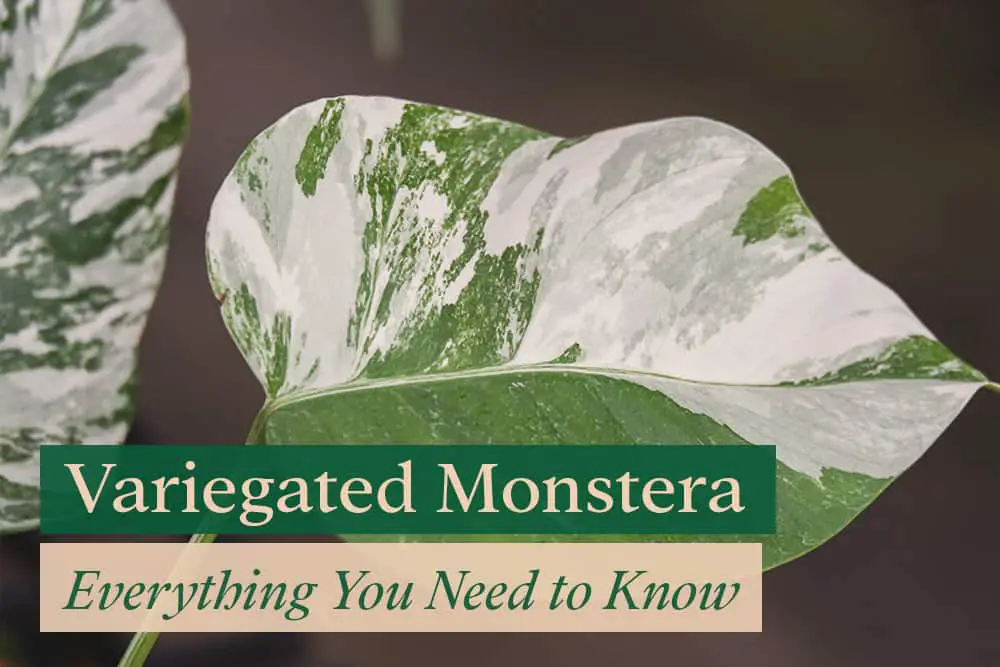
If you’re a plant lover, then you’ve probably heard of the Variegated Monstera. This gorgeous plant is a variegated form of the popular Swiss cheese plant, and it’s loved for its beautiful foliage.
Unlike its green counterpart, the Variegated Monstera is expensive and difficult to find. But if you’re lucky enough to get your hands on one, you’ll be rewarded with a plant that’s sure to make a statement in your home.
In this article, I’ll tell you everything you need to know about Variegated Monsteras, including:
- What is special about a Variegated Monstera plant?
- How to differentiate Variegated Monstera
- Popular varieties of Variegated Monstera
- Special care requirements for Variegated Monsteras
- Common problems with Monstera Variegata
- Buying guide for Variegated Monsteras
Now let’s get started!
What is Special About a Variegated Monstera Plant
The most obvious difference between a Variegated Monstera and its green counterpart is the foliage. While the leaves of a regular Monstera are solid green, the leaves of a Variegated Monstera are splashed with white or yellow.
Causes of Variegation in Monsteras
Generally, plants with color or pattern have their variegation written into their genes. This means that the plant’s parents both had variegated leaves, and the variegation was passed down to the offspring.
However, the case is different for Monstera Variegata.
The variegation on Monstera leaves is caused by a genetic mutation that prevents chlorophyll from being produced in some areas of the leaves.
Can you Make a Monstera Variegated?
While there is a lab in Thailand that can create Variegated Monsteras through tissue culture propagation, it’s not possible to create one at home.
The genetic mutation that causes Variegation is random, and the chance of it happening to your regular Monstera is pretty much equivalent to winning the lottery.
The best way to get your hands on a Variegated Monstera is to buy one from a reputable nursery or plant retailer.
Why are variegated monsteras so expensive?
In recent years, the Variegated Monstera has become one of the most popular houseplants. As a result, the demand for this plant has increased.
On the other hand, the supply of Variegated Monsteras is very limited because they’re slow-growing and difficult to propagate.
This combination of high demand and low supply has driven up the price of these plants.
How Much Does a Variegated Monstera Cost?
The price of a Variegated Monstera can range from $200 to $1,000, depending on the size and variegation pattern.
The current world record for the most expensive Variegated Monstera is $$27,100! This is for a very rare white variegated Rhaphidophora Tetrasperma with just 8 leaves, with the 9th just about to uncurl.
How to Differentiate Types of Variegation
Several types of variegation can occur on Monstera leaves. They can be categorized based on the colors and patterns of the variegation:
Three Variegated Colors
The mutation of the Monsteras varies in three different colors: White/cream, yellow, and light green color.

White Variegation (Monstera Albo)
The word Albo in Latin means “white.” As the name suggests, Monsteras with this type of variegation have a green base with white or cream-colored patches on their leaves.
This is the most common type of Variegated Monstera and also the most popular.
Yellow Variegation (Monstera Aurea)
The word Aurea in Latin means “golden.” These Monsteras have a green base with yellow or gold patches on their leaves.
As Aureas are rarer than white variegations, they are more expensive.
Green Variegation (Monstera Sport)
Recently, Monstera Sport has been popularized as the mint variation. There is something unique about the combination of lighter and darker green patches on the leaves of this plant.
Three Types of Variegation Pattern
The variegation on Monstera leaves can also be categorized based on the patterns:

Marble Pattern
This is the most common pattern for Variegated Monsteras. The variegation on the leaves appears in a random, evenly distributed, and marble-like pattern.
Sectoral Pattern
The variegation on the leaves appears in irregular patches or clumps. The leaves may have one large patch or multiple small patches of color.
Half Moon Pattern
This pattern divide the leaves into two distinct colors, usually green and white. The line between the two colors is usually straight, giving the leaf a half-moon shape.
It is also common to see a combination of two or more patterns on the same leaf.
Popular Varieties of Variegated Monstera
Alright, now that we’ve covered the basics of Variegated Monsteras, let’s take a look at some of the most popular varieties:
Also read: 10 Most Popular Monstera Varieties: Complete Guide (Pictures & Cost)
Monstera Deliciosa Albo Variegata
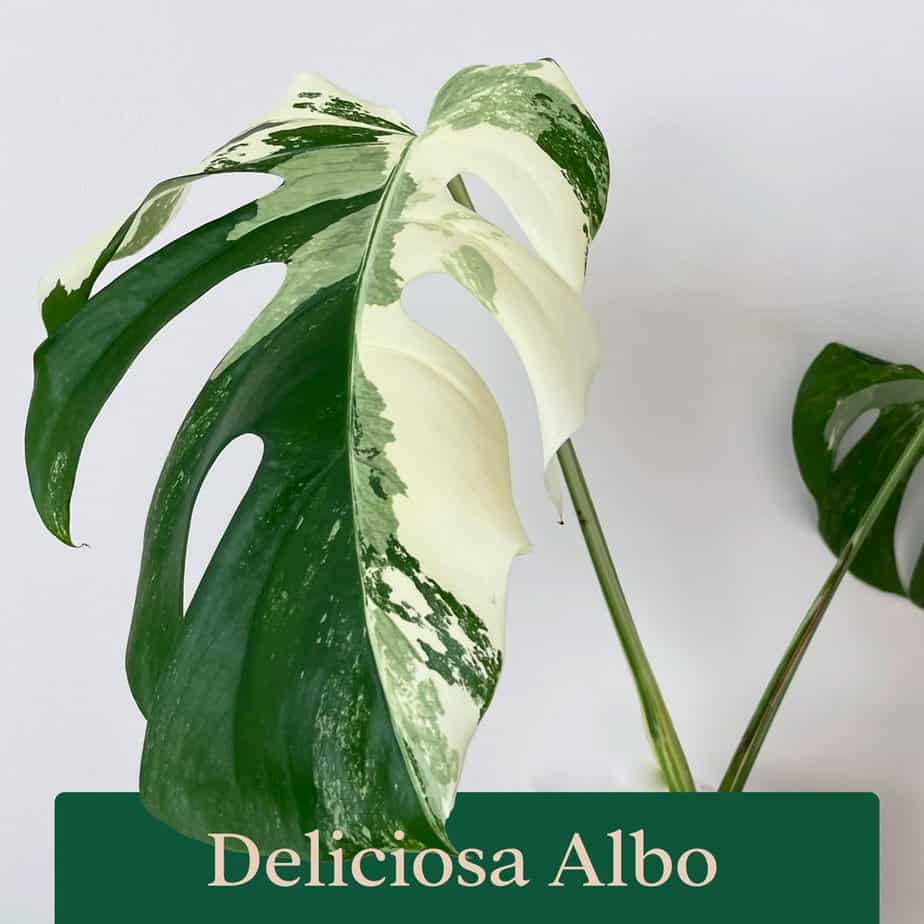
The Deliciosa Albo is regarded as the rarest of all the Variegated Monsteras. As the name suggests, it is the white variegation of the regular Monstera Deliciosa.
The large leaves of the Deliciosa Albo are a beautiful green color with white patches. Variegation can appear in different patterns on each leaf, making each one unique.
The variegation of Deliciosa Albo is unstable, so the plant can sometimes lose its variegation if it is not cared for correctly.
The price tag for a Deliciosa Albo can range from $200 to $1,000. But, the highest price ever paid for a Monstera Deliciosa Albo was $4,930!
Monstera Thai Constellation Variegata

The Thai Constellation is a man-made species of Monstera variegata that was grown in a lab using a tissue culture technique in Thailand.
There is a distinctive spackled pattern on Thai Constellation that sets it apart from other Variegated Monsteras. In contrast with Albo, it typically has a creamier white color or a yellow/cream color.
The variegation in Thai Constellation is stable, meaning the variegation will be retained in its new growth despite changes in growing conditions.
Although not as expensive as some of the other Variegated Monsteras, Thai Constellation cuttings usually sell for around $100 to $200.
Monstera Albo Borsigiana

The Monstera Albo Borsigiana has smaller leaves than the Deliciosa Albo, but it is otherwise similar in appearance.
Even though this variety grows slowly, it still grows faster than Deliciosa Albo. That is why you will often see Albo Borsigiana listed as a more affordable alternative to Deliciosa Albo.
The price of an Albo Borsigiana can range from $100 to $600, depending on the size of the plant.
Monstera Adansonii Variegata
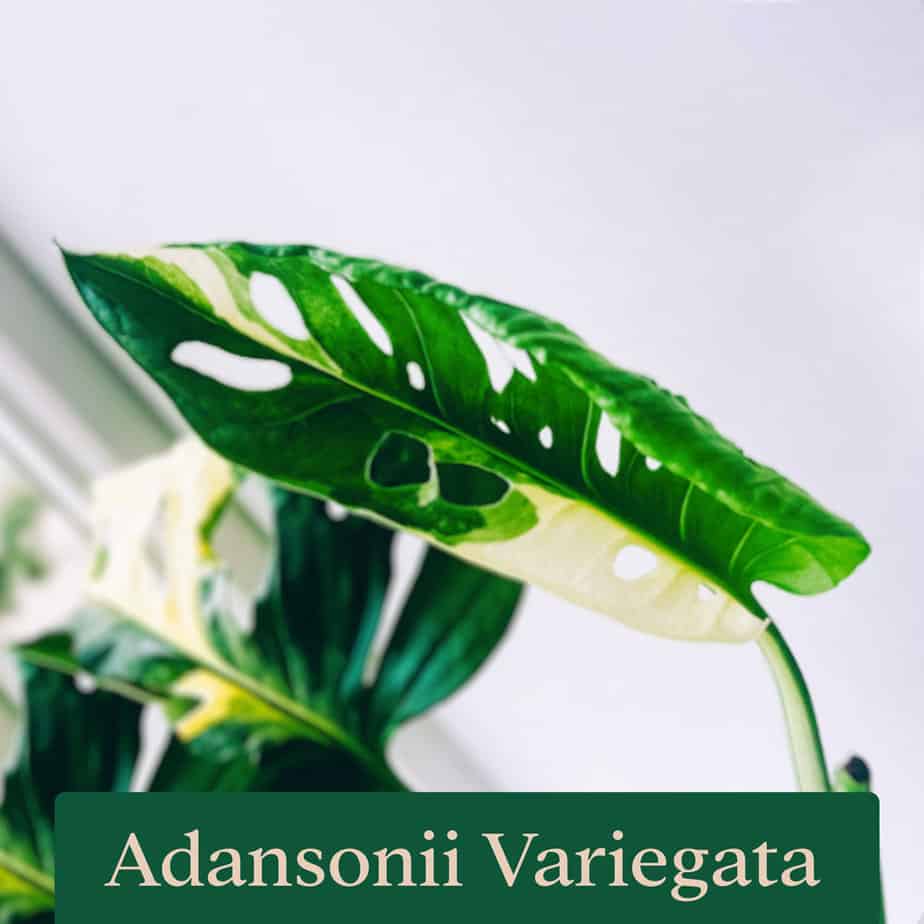
There is no doubt that this is my favorite variegated Monstera. On Adansonii Variegata, the variegation generally ranges from half moon cream white splits to speckled yellow.
Usually, the cream white variegation is sold for a higher price than the speckled yellow. This is because the cream white variegation is less common and more difficult to find.
Adansonii Variegata can range in price from $100 to $700 depending on the size of the plant and the rarity of the variegation pattern.
Monstera Deliciosa Aurea (aka Marmorata)
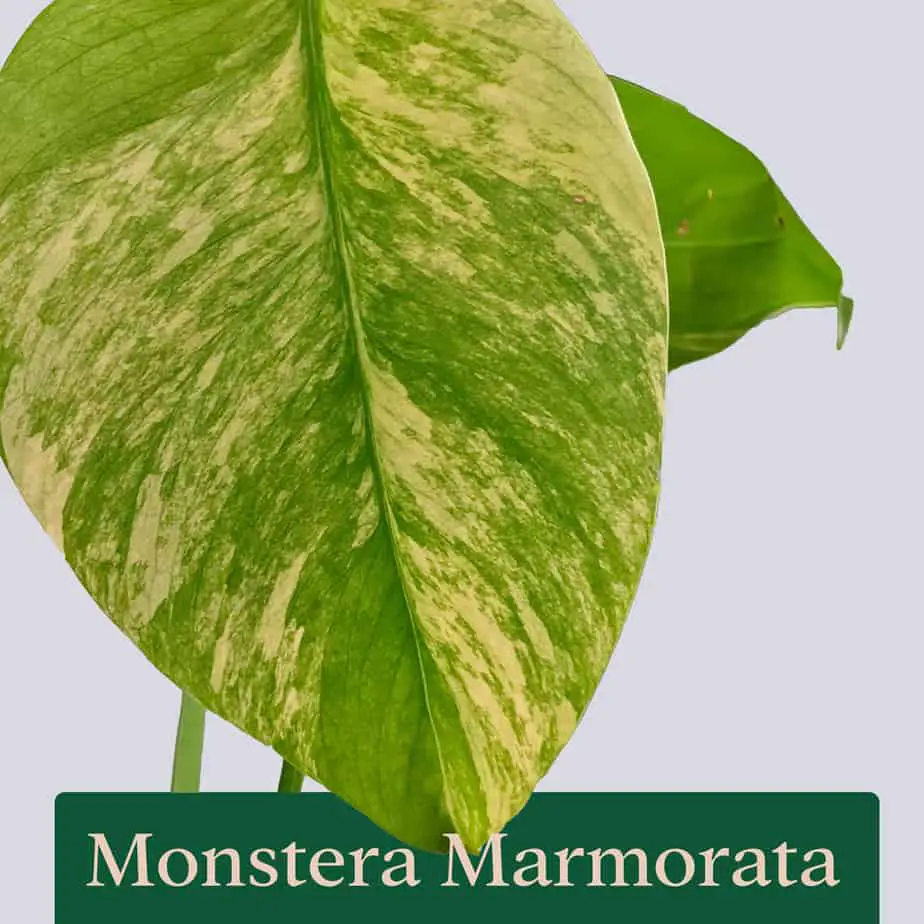
The Aurea, or Marmorata, is a variety of Monstera Deliciosa with a yellow sectoral variegation pattern.
It is very rare to find a Marmorata in nurseries or online because it is difficult to propagate. The variegation is unstable and can be lost easily during propagation.
Marmoratas are usually sold for $300 to $2,000 depending on the size of the plant.
Mint Monstera
The Mint Monstera is extremely rare and hard to find. As the name suggests, it has a combination of minty green or white-green variegation with a marbled variegation pattern.
Due to its rarity, I could not find one listed below $2,000 for a single leaf cutting. So, if you ever come across one for sale, be prepared to pay a high price!
Special Care for Variegated Monstera
Now that we’ve gone over some of the most popular Variegated Monsteras, let’s talk about how to care for them.
A variegated Monstera requires extra care because it is more sensitive to changes in its environment and can revert to all green if it is not cared for properly.
Here are some tips for caring for your Variegated Monstera:
Use Well-Draining Soil
Variegated Monsteras need a well-draining and aerated soil that is rich in organic matter. I recommend using a potting mix that is specifically designed for tropical plants.
You can also make your own potting mix by mixing orchid bark (25%), coconut coir (20%), perlite (25%), activated charcoal (10%) and worm casting (5%).
If you can’t find any of these ingredients, you can use an all-purpose potting mix and add extra perlite or pumice to improve drainage.
Make Sure Drainage Hole in Pot is Large Enough
The drainage hole in your pot should be large enough so that water can drain freely and the roots don’t sit in the water. Otherwise, your plant will develop root rot.
I recommend using a pot that is at least 6 inches wider than your Variegated Monstera’s root ball and has a drainage hole that is at least 1 inch wide.
Moss pole is a MUST
Variegated Monsteras need support to climb and the best way to provide this support is by using a moss pole.
A moss pole is a long, slender pole that is covered in moss. It gives the plant’s aerial roots something to grip on as it grows.
You can buy a ready-made moss pole or make your own by wrapping a thin layer of sphagnum moss around a bamboo or plastic pole.
Make sure the moss is damp but not wet before you wrap it around the pole. You can also use velcro strips or plant twist ties to secure the moss in place.
Temperature & Humidity
Variegated Monsteras prefer a warm and humid environment. They will tolerate some temperature fluctuations but sudden changes can cause the leaves to brown or drop off.
The ideal temperature for a Variegated Monstera is 65-80ºF (18-27ºC). Prolonged exposure to temperatures below 50ºF (10ºC) can damage the plant.
Additionally, Variegated Monsteras need high humidity to thrive. The ideal relative humidity is 60-80%. If the air is too dry, the leaves will start to brown and curl at the edges.
To increase the humidity around your plant, you can use a plant humidifier or place the pot on a pebble tray filled with water.
Pebble trays are simply shallow trays filled with gravel or rocks and water. As the water evaporates, it increases the humidity around the plant.
Also read: Plastic Bag for Plants: Can It Improve Humidity
Light Considerations for Variegated Monstera
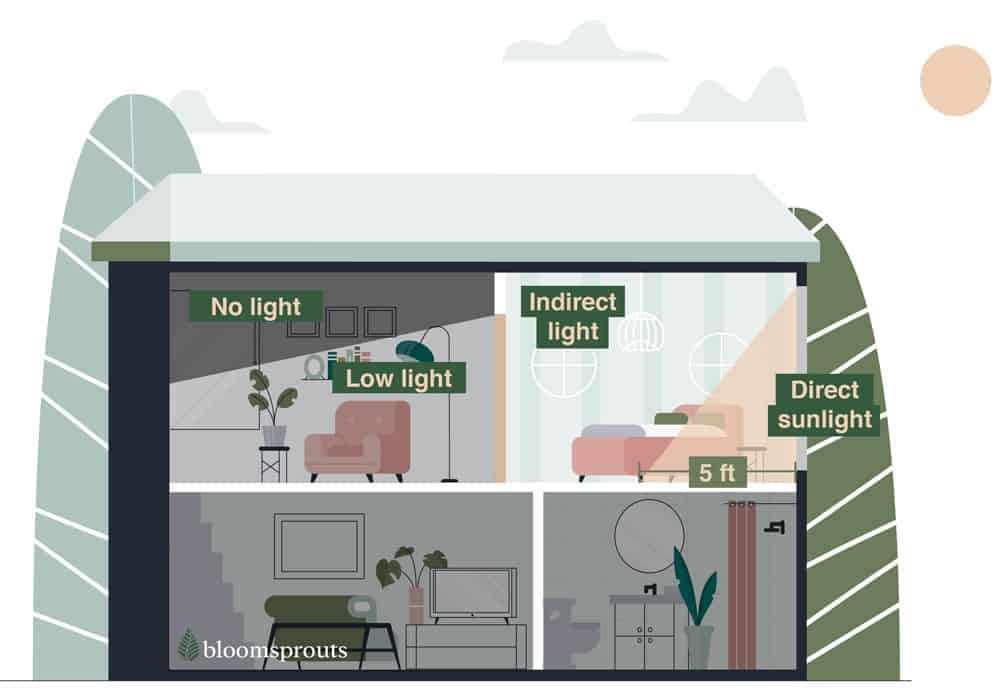
All Monsteras need at least 6 hours of bright, indirect light to thrive but Variegated Monsteras are even more sensitive to changes in light.
If the light is too low, the variegation will start to fade and the leaves will become all green. If the light is too intense, the leaves will develop brown scorch marks.
The best place to put your Variegated Monstera is in an east- or west-facing window. You can also use a grow light if you don’t have a bright enough spot in your home.
Watering Your Variegated Monstera
Variegated Monsteras like to have moist soil but they don’t like to sit in water. The best way to water your plant is to use the “ finger test.”
To do this, stick your finger into the potting mix up to the second knuckle. If the mix feels dry, it’s time to water. If it feels moist or cool, wait a few more days before watering.
When you do water your plant, make sure to use lukewarm water and let it drain freely from the pot. Avoid getting water on the leaves to prevent leaf spot disease.
Fertilizing Your Variegated Monstera
Variegated Monsteras are heavy feeders and they need to be fertilized regularly to stay healthy. I recommend using a balanced fertilizer (20-20-20) once a month during the growing season.
Refrain from fertilizing your plant in the winter when growth slows down. Too much fertilizer can damage the roots and cause the leaves to turn brown or drop off.
It’s also a good idea to flush the potting mix with water every 2 weeks to prevent the buildup of salts.
You can use a liquid fertilizer or slow-release fertilizer pellets. If you use liquid fertilizer, make sure to dilute it to half the recommended strength.
It’s also a good idea to fertilize your plant with compost or worm castings once a month during the growing season. This will give your plant a boost of nutrients and help it stay healthy.
Repotting
Your Variegated Monstera will need to be repotted every 1-2 years. The best time to repot your plant is in the spring before new growth appears.
Use a pot that is only 2 inches wider than the current pot. A pot that is too big takes longer to dry out and can lead to root rot.
When repotting, gently remove the plant from the pot and inspect the roots. If they are tightly bound or have started to circle the pot, it’s time to repot.
Pruning to Preserve Variegation
Sometimes your variegated Monstera leaves will start to revert back to all green.
To prevent new leaves from being all green, you have to prune your Monstera Variegata to the last variegated leaf. This will encourage the plant to re-sprout from another growth point and produce variegated leaves.
Also, while all white variegated leaves (full moon) are beautiful, they don’t have any chlorophyll and won’t produce food for the plant. Pruning these leaves will help your plant focus its energy on producing new leaves.
The best time to prune your Variegated Monstera is in the spring when new growth appears.
Propagating Variegated Monstera
The best way to propagate Variegated Monstera is by stem cuttings.
To do this, take a cutting from the main stem that has at least 2-3 leaves and a node. Make sure to use a sharp knife or shears so you don’t damage the plant.
Remove the bottom leaf and dip the cutting in the rooting hormone. Plant the cutting in a pot of moistened potting mix.
Place the pot in a bright spot but out of direct sunlight. Keep the soil moist but not soggy and wait for the cutting to root, which can take up to 8 weeks.
Once the cutting has rooted, you can transplant it into a larger pot.
If you bought a variegated Monstera wet stick (a stem with no leaves), you can propagate it in the same way.
Common Problems for Monstera Variegata and How to Fix It
Variegated Monsteras are pretty tough plants but they can still experience some problems. Here are some common issues and how to fix them:
Leaves Turn Back to Green
If the leaves on your Monstera Variegata start to turn back to all green, it’s usually because the plant isn’t getting enough light.
Make sure to place your plant in a bright spot that gets at least 6 hours of indirect sunlight per day. If you don’t have a bright spot, you can supplement with grow lights.
You can also try pruning the plant to encourage new growth. Cut back the stems to the last variegated leaf and new variegated leaves should start to grow.
Yellowing Leaves
If the leaves on your Monstera Variegata start to turn yellow, it could be due to several reasons. However, the most common reason is that the plant is getting too much water.
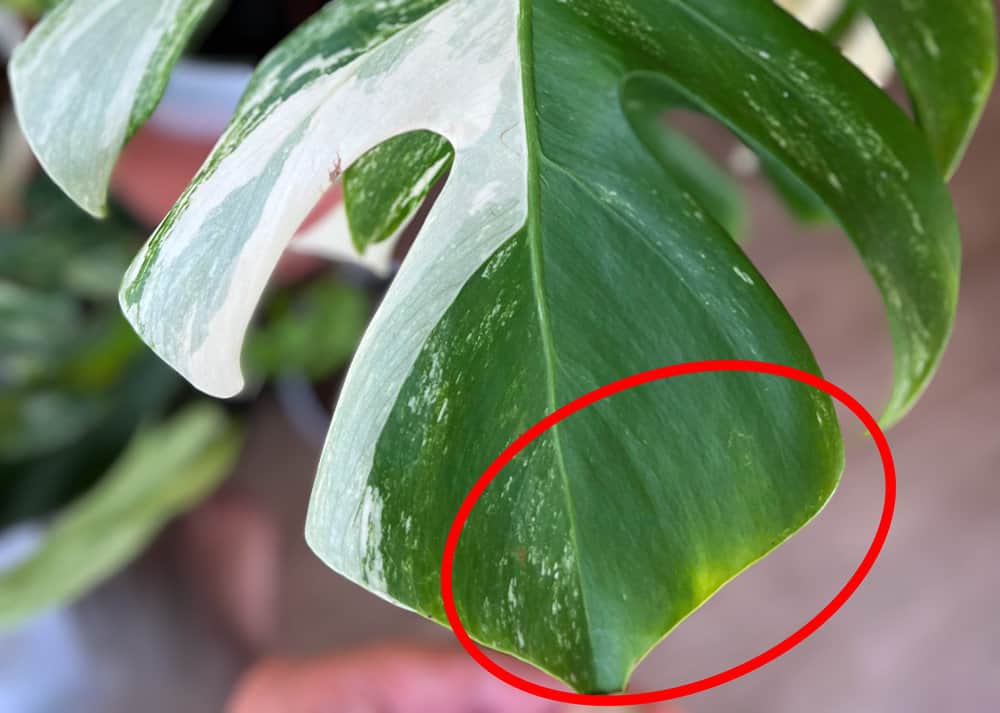
Make sure to let the top inch of soil dry out before watering your plant again. Also, make sure you are using a well-draining potting mix and a pot with drainage holes.
If the leaves are yellow and mushy, it’s a sign of root rot and you will need to repot your plant in fresh potting mix.
There are other reasons for yellowing leaves, you can check my article on why leaves turn yellow for more information.
Drooping & Wilting Leaves
If the leaves on your Monstera Variegata start to droop or wilt, it’s usually because the plant is not getting enough water.
Water your plant thoroughly until water runs out of the drainage holes. Make sure the potting mix is moist but not soggy.
Similarly, you can also visit my article about why Monstera leaves droop for more information.
Slow Growth
Variegated leaves have less chlorophyll which means the plant has a hard time producing food. As a result, growth is usually slower compared to all green Monsteras.
Make sure to give your plant bright indirect light and fertilize it regularly to encourage growth. You should also prune all white leaves so the plant can focus its energy on producing new leaves.
Root Rot
If you smell a foul odor or see mushy yellow leaves, it’s a sign of root rot. Root rot is caused by overwatering and can quickly kill your plant.
The best way to fix root rot is to repot your plant in a fresh potting mix. Make sure the pot has drainage holes and only water your plant when the top inch of soil is dry.
If the roots are severely damaged, you might have to cut them off. In this case, you can propagate the plant from stem cuttings.
Buying Guide for Variegated Monstera
When buying a Variegated Monstera, there are a few things to consider:
Buying a Full Plant vs Cuttings vs Node
The easiest way to get a Variegated Monstera is to buy a full plant. However, these plants can be expensive and may not be readily available.
If you’re on a budget, you can also buy stem cuttings or nodes. These are cheaper but will take longer to grow into a full plant.
The price of a full plant of Monstera variegata can range from $300 to $2,000 while cuttings are usually around $150 and a node is around $50.
How quickly do cuttings grow?
Cuttings usually take 6 to 8 weeks to grow roots and 2 to 3 months to grow new leaves. However, growth can be slower for variegated Monsteras due to the lack of chlorophyll.
In my experience, it can take up to 4 months for a variegated Monstera cutting to grow new leaves.
Where to Find Variegated Monstera
Variegated Monsteras are hard to find and can be very expensive. The best way to find one is to check your local plant nurseries or search online plant retailers, such as Etsy.
Another option is to check online plant forums and social media. Some members may be willing to sell or trade their plants.
Tips on purchasing variegated plants
Here are a few tips to keep in mind when purchasing variegated plants:
1. Don’t Buy Variegated Monstera Seed
There is no such thing as a variegated Monstera seed. All variegated Monsteras are mutations that occur naturally and cannot be reproduced through seeds.
Also read: Growing Monstera Deliciosa from Seeds – Is It Possible?
2. Don’t Buy Monstera Variegata Without a Node
A node is a small bump on the stem where leaves and roots grow. Variegated Monsteras without nodes will not grow new leaves and will eventually die.
So, make sure to buy a plant that has at least one node.
3. Don’t Buy Full White Variegated Monstera
As I said earlier, all white leaves do not contain chlorophyll which is necessary for the plant to produce food.
As a result, full white variegated Monsteras will not grow new leaves and will eventually die.
4. Don’t Mistake Variegation with Mosaic Virus in Monstera or Nutrient Deficiency
Some people mistake variegation for mosaic virus or nutrient deficiency.
A mosaic virus causes yellow and green patches on Monstera variegata leaves, resembling the yellow (Aurea) or green (sport) variegation.
The best way to tell the difference is to look at the shape of the leaves. Mosaic virus leaves are usually distorted while variegated leaves are not.
Iron and magnesium deficiency can also cause yellow and green patches on Monstera leaves. Feeding your plant a nutrient-rich fertilizer can help fix this issue.
Also read: Do I Have a Variegated Monstera Plant? Here Are the Signs!
